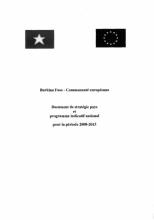
A landlocked Sahelian country, Burkina Faso counts among the world's poorest. It has a population of 13.7 million (2006 figures) and a surface area of 274 000 km². With few natural resources and a deteriorating natural environment, it is also subject to the imponderables of a Sahelian climate; rainfall is often inadequate or unevenly distributed. The economy is mainly based on the agricultural sector, which is heavily dependent on rainfall and, employs approximately 80% of the country's workforce and generates 37% of GDP, but also on the service sector, which is partly informal and constantly growing. It has the disadvantages of high factor costs and a heavy dependence on exports of cotton and livestock products. Moreover, trends in the dollar exchange rate and world prices for cotton and oil products have been very unfavourable over the last few years.
Despite macroeconomic progress (with growth averaging 6.4% from 2001 to 2005, one factor being better rainfall than in the 1990s) and significant flows of foreign aid, recorded results as regards the improvement of living conditions, the fight against poverty and the satisfaction of social needs are still limited; per capita GNP in 2004 was USD 303, and 42.4% of the population live below the poverty threshold, according to a 2005 estimate. Burkina Faso, as a member of the West African Economic and Monetary Union (WAEMU), has the same currency (the CFA franc) as seven other countries.
In view of the population's extreme poverty and vulnerability, the Government has drawn up a Poverty Reduction Strategic Programme (PRSP) based on four key areas of activity: i) boosting the pace of growth and ensuring that it is equitable, ii) ensuring that the poor have access to basic social services and social protection, iii) broadening opportunities, on an equitable basis, as regards employment and income-generating activities for the poor, and iv) promoting good governance. This new strategy has been validated by all donors, including the EU and EC Member States, whose overall aid accounts for over 50% of the total.
As regards governance, the country has been on the path towards democracy since the early 1990s, but this process needs consolidation, and the opposition is still very weak by comparison with the coalition in power. A major challenge for the years ahead is the de facto transfer of responsibilities and resources to local government, following the municipal elections of April 2006. Burkina Faso has a satisfactory framework of laws and regulations in the field of human rights and the rule of law, but follow-up and enforcement need to be strengthened. Special efforts need to be made to step up the fight against corruption.
Within the framework of 10th EDF planning, EC aid policy will be fully integrated into the government strategy for the combating of poverty and will be consonant with the major principles of EU development cooperation. The main areas selected, with a view to helping reduce poverty and ensuring coherence and complementarity with the activities of other donors, particularly European ones, are as follows:
- Strengthening basic infrastructure and interconnectivity (transport, water and sanitation, energy), accounting for about 26% of resources;
- Support for political and local governance (justice, decentralisation), including measures to accompany budget support, accounting for about 10% of resources;
- Support for the macroeconomic framework and poverty reduction through direct budget support, representing about 60% of resources.
About 4% of resources are earmarked for non-focal sector activities, notably integration and regional cooperation (EPA, environmental protection) and institutional support.
| Attachment | Size |
|---|---|
| scanned_bf_csp10_fr.pdf | 869.81 KB |
